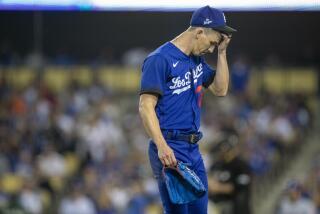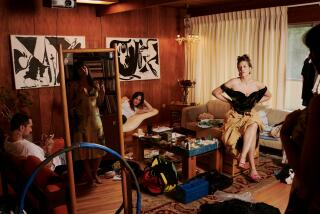DeShields Is Dressed for Success
- Share via
When you first spot the Dodgers’ Delino DeShields in a baseball uniform, you figure you have wandered into a time warp. There are the pants neatly folded at the knee. There are the socks, perfectly visible, with the calf showing and the stirrup centered at the ankles.
You wonder what he’s doing there in that crowd of athletes who look as if they have just escaped a hotel fire in their pajama bottoms or lost the elastic in their knickers.
Delino even has the closest thing to old-fashioned baseball shoes, conservative black ones and not the gaudy space-cadet footwear favored by most players with gadgets for pumping air and a color scheme out of a psychedelic nightmare.
John McGraw would approve. DeShields looks the way a ballplayer used to look. The way Ty Cobb looked. Rogers Hornsby. Willie Mays.
Like to see Willie Mays playing in pajama bottoms, would you? Henry Aaron? I should say not.
DeShields does it for the noblest of purposes: He wants to honor his game’s past, its old-time ballplayers. He wants to pay tribute to baseball’s greats, not only the earlier major leaguers but also the giants of the Negro Leagues who contributed to the lore.
It’s not a crusade with him, just a personal touch. He doesn’t expect to bring back the old tintypes of the game, he just feels comfortable in the traditional costume.
“I appreciate the guys who built this game, “ he tells you sincerely. “It’s my way of saying thanks. I realize times are a lot different, but I want to identify with guys who played this game for the love of it, who didn’t make a lot of money out of it but who made the game what it has become for the rest of us.”
One result of this attitude is DeShields stands out in a modern lineup like a guy wearing a tux in a bowling alley. You picture somebody saying, “Pull your pants down like everyone else--your legs are showing! What are you, some kind of troublemaker?”
For old-time baseball fans, it’s kind of refreshing. Comforting. DeShields is right off a 1960 bubble-gum card. A picture of him sliding into second could be right out of a Spalding Baseball Guide of World War I vintage. You imagine Christy Mathewson dressed this way.
Of course, clothes don’t make the ballplayer. Putting on a cape doesn’t make you Superman. And dress codes have long since gone by the boards. If you don’t think so, count the tank tops in a once-swank restaurant the next time you go there. We’ll be back in loincloths by the end of the century, is the bet here.
But it’s more than a wardrobe to Delino DeShields. It’s a kind of a mind-set. DeShields is kind of an old-fashioned ballplayer. He shows up for the team bus. He’s quiet, dependable, alert, consistent, grateful to be in a game that can pay him those sums. He takes nothing for granted. Somebody built this.
He’s never going to bat .400 or menace Hornsby’s or even Ryne Sandberg’s records. He’s not a home run threat. But neither is he a threat to throw a baseball at a fan, aim his car at fleeing kids, floor an umpire, miss batting practice, cork a bat or threaten a female announcer.
He wants to be a throwback in something other than trouser length or stocking-showing. He wants to be the type of player who wore those clothes--the guy who will steal a base, drag a bunt, work the pitcher, hit behind the runner, keep the game close.
The player he reminds me most of is one of my all-time favorites, the late Jim Gilliam. Jim was a no-nonsense, on-time-for-the-game, reliable employee who could play seven positions well, turn the double play, walk 96 times a season, bat behind Maury Wills and still be the Dodgers’ quiet man, a manager’s dream.
Delino DeShields does many of the things Jim Gilliam used to do. Gilliam was rookie of the year in 1953, DeShields finished second in the voting (to Atlanta’s Dave Justice) in 1990.
They both more or less specialized in the three-base hit. Gilliam led the league with 17 one year. DeShields is currently second in the league with four. The three-bagger is not entirely a function of speed (although Willie Davis got a triple every time the ball got past the pitcher’s mound). It is also a product of canny baserunning and judgment.
DeShields led the Dodgers in stolen bases last year with 39. Jim Gilliam had the disadvantage of playing behind Jackie Robinson or Maury Wills most of his career but still led the club in stolen bases twice.
If DeShields had a fault early, it was that he was a Will Rogers hitter. He never met a pitch he didn’t like. He struck out 151 times in 151 games one season. He swung at such bad pitches, the pitchers weighed rolling the ball to him to see if he’d bite.
Leadoff hitters are not supposed to swing at bad pitches. And sometimes, not even at good ones. DeShields lost his leadoff spot but has since become more discriminating. Two years ago, he led the league in examining pitches for flaws, looking at a league-high 2,277 pitches and letting more than 65% of balls thrown to him go by.
He even makes a study of his base stealing. “I make a distinction between ‘quality’ steals and ‘quantity’ steals,” he tells you earnestly. There are times when the risk isn’t indicated. “You don’t steal a base just because you can. You don’t steal a base with [Mike] Piazza coming up. You steal a base with two out when you need a run. You steal a base when they know you’re going to steal a base. That’s a quality steal.”
He has eight quality steals this year, third in the league.
If you’re not going to look like Ty Cobb or Josh Gibson in the record books, DeShields feels you might as well look like them on the field. A lot of guys in the game today will never make it either way. Look at it this way: Nobody with his pants legs down around his shoe tops ever got confused with Ty Cobb in any way. Maybe it’s just as well they let their pants hang down. Matches their averages.
More to Read
Are you a true-blue fan?
Get our Dodgers Dugout newsletter for insights, news and much more.
You may occasionally receive promotional content from the Los Angeles Times.









